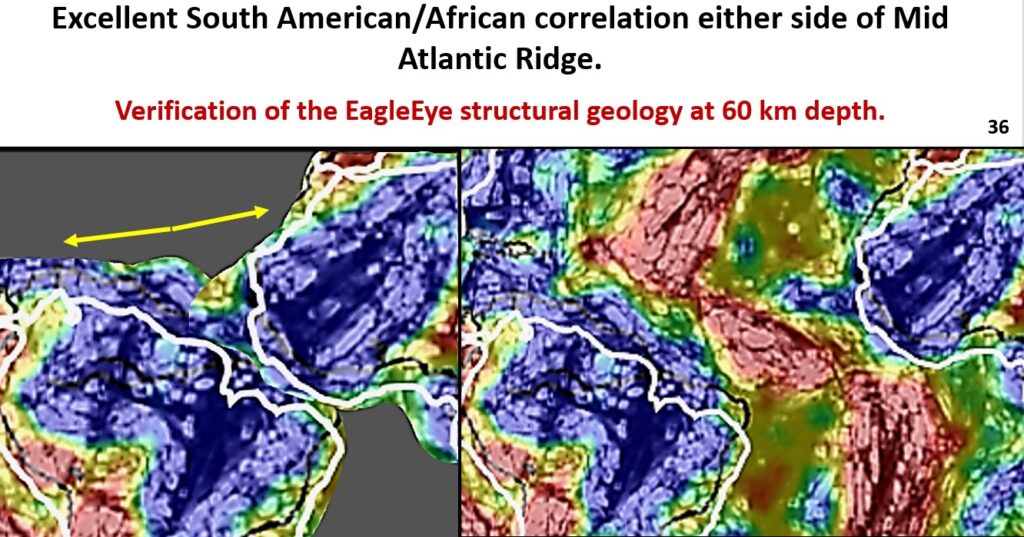The AusIMM webinar I did on this new research can be seen on the AusIMM website or on https://www.youtube.com/watch?v=snu8En442Js
This figure shows the relative speed of the movement of the various blocks, or plates, of Earth. I prefer to use the term ‘block’ for what are currently called ‘plates’ because there is strong evidence they extend as a rigid block to the inner core and are not just thin surface ‘plates’ as is currently hypothesised.
Block movements.
The North American/Eurasian continent block is effectively stable.
The main movement originates in the Pacific Ocean, the Mid Atlantic Ridge and the Antarctic/Australia separation rift. The Pacific block is moving NW, and the Nasca and Cocos blocks to the east.
South American block is moving north. The African and Indian/Australian blocks are moving north east.
The differential movement between blocks is taken up by; subduction zones around the Pacific Ocean, the Mid Atlantic Ridge extension zone, the collision zones between the stable North American/Eurasian block and the northward moving South American, African and Indian/Australian blocks.
We will be looking later at seismic tomography sections through the northern and southern hemispheres (see traverse lines) and the geology of block ‘margin’ areas (yellow boxes) to see how the crust of the Earth relates to the lithosphere and core and the nature, and depth extent and attitude of the block margins.
To give us a clear idea of how the Earth is constructed, and moving, we will be first looking at the Mid Atlantic Ridge and the African Rift System, then around the southern hemisphere from the Indian Ocean through Australia to South America and then across the Pacific Ocean, through South America and the Atlantic Ocean to West Africa.
Mid Atlantic Ridge.
We will first be looking at the correlation of South America and Africa either side of the mid-Atlantic Ridge. We will also be looking at the African Rift System using seismic tomography plan and sections and closely looking at the structure of the African rift to assess if they shows verification of the EagleEye system structural geology in both plan and section.
Global seismic tomography data at 60 km depth, from French and Romanowicz, 2014, was used as the base set of data for this research. This is part of an excellent set of seismic tomography plans at 175 km depth intervals from 60 – 2775 km depth.
Global brittle tectonics and structural directions.
Note the 020° (South America to Europe, Antarctic to Western Australia to Japan) and 110° (south from Australia to Madagascar to West Africa to Alaska and the central Pacific to Greenland) strong structural directions which I suggested in part 9 are related to asymmetric tidal gravity forces from the 23° axis tilt, and the sun and moon.
We will be looking at the geology of the mid-Atlantic Ridge in the Atlantic Ocean (red box). The Mid-Atlantic Ridge separation of Africa and South America started the whole continental drift – plate tectonics hypotheses back in the 1950s and 60s (which I well remember 😊.
The Mid-Atlantic Ridge region is extremely well known on the surface but almost nothing is known about it at depth. This will be discussed when we later look through a section from North America to Iceland to Europe.
Looking at the EagleEye enhanced structural geology of Africa and South America on either side of the Mid Atlantic Ridge, near the equator, it can be seen that the brittle looking geology correlates very well.
The left-side image shows the geology as it would have been 200 million years ago. The right-hand side shows the current geology after the opening of the mid-Atlantic Ridge. This correlates very well with the accepted geology of this Mid Atlantic Ridge area, further verification that the EagleEye system produces factual geology in known structural areas.
African Rift System.
We will be looking next at the African rift (part 11) using seismic tomography plan and sections and closely looking at the structure of the African rift as it shows verification of the EagleEye structural geology in both plan in section.
Cheers and keep researching
Bob

